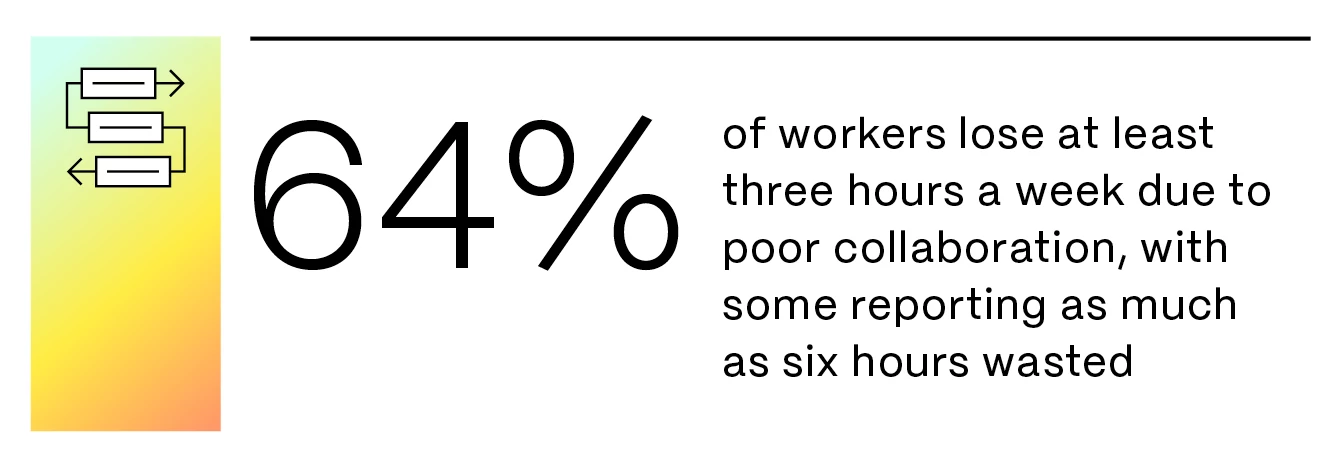
Blog
Content collaboration guide: benefits and tips for productivity

Ever since Bill Gates wrote his essay "Content is King" in 1996, it has remained a constant truth. In today's over-saturated digital world, good content is king. However, churning out high-quality content consistently can feel like an uphill battle for businesses.
The culprit? Communication breakdowns. Studies show a staggering 64% of workers lose at least three hours a week due to poor collaboration, with some reporting as much as six hours wasted.

This article can help you improve collaboration and get back on track with productivity. Read on to understand the power of content collaboration tools and gain tips and best practices to streamline your content creation process.
What is content collaboration?
Content collaboration is the process of working with others to create, edit, store, and share a piece of content. The output ranges by industry but can involve anything from developing a real estate listing to drafting a brochure on insurance offerings.
Previously, content creation was often a solitary or siloed endeavor, hindered by a lack of team and cross-departmental collaboration. Without a streamlined system to manage and share content effectively, issues can arise. This can include things like inconsistencies in messaging, missed opportunities for synergy, and inefficient resource allocation were commonplace.
Thankfully, content collaboration platforms have revolutionized the process. These platforms act as a central hub for everything content related. Imagine real-time co-creation, streamlined workflows, and crystal-clear communication channels – all rolled into one. The result is a productivity boost, a team that thrives on collaboration, and content that generates results.
While content collaboration tools are incredibly helpful for increasing teamwork and productivity, successful content collaboration goes beyond the tech. To truly unlock the power of these platforms and streamline your content creation process, you need to understand the art of collaboration itself.
How does content collaboration work?
Content collaboration works by establishing a well-defined approach and workflow to ensure a smooth journey from idea to publication.
Here's a breakdown of what this approach should look like:
- Planning and ideation: To get started, set up brainstorming sessions or online idea boards to involve all stakeholders in generating content ideas that align with your goals. Collaboration brings diverse perspectives into your content to help resonate with target audiences.
- Content creation: Next, you and your team can get started on developing the planned content. This stage may involve writers, designers, and editors working together. Collaboration tools offer real-time co-creation on documents and shared workspaces, promoting consistency and efficiency.
- Review and feedback: Once your content is developed, circulate drafts for feedback from team members and key stakeholders. If you’re using a collaboration platform, built-in commenting and annotation tools help facilitate efficient responses.
- Revision and approval: After content is reviewed and feedback is given, it’s time to make revisions. During this stage, content goes through a final approval process, often involving multiple reviewers. Collaboration tools help tap the right people with notifications to stay on deadline and ensure revisions are tracked effectively.
- Publication and distribution: When final approval is given, the content is ready for its final destination. Plus, collaboration platforms guarantee the final version is securely stored for future reference.
Related Read: How to build a content creation workflow that works

Benefits of content collaboration in business
Content collaboration brings several benefits to businesses, including streamlined workflows and boosted productivity.
A few key advantages include:
- High-quality content: Collaboration allows you to tap into a pool of expertise. This means richer, more well-rounded content in less time. Multiple minds working together help catch knowledge gaps and confirm accuracy.
- Faster creation: Collaboration and content management tools can uplevel content creation. It keeps everything moving forward efficiently with benefits like real-time co-creation, centralized communication, and streamlined task management. This eliminates the need for lengthy email chains and version control headaches.
- Consistency and timely delivery: Collaboration platforms ensure your content sticks to brand or regulatory guidelines and stays factually on point. It helps reduce errors and hit deadlines more consistently with feedback loops, version control, and communication streams that keep everyone aligned.
Additionally, strong team engagement, fostered by collaboration, can lead to 23% higher profitability, 78% lower absenteeism, and 21% lower turnover for businesses.
Content collaboration tools to supercharge productivity
With remote and hybrid work now a standard practice for businesses, tech-based content collaboration tools are no longer a perk, they're essential. These platforms are the key to seamless teamwork, no matter where your team is located.
Many modern collaboration tools are powered by artificial intelligence (AI) and machine learning. Real-time co-editing on documents, automated task allocation, and even smart feedback suggestions are all possible thanks to AI.
The result? Streamlining content creation like never before. In fact, studies show 75% of leaders whose teams use AI say they collaborate better.
Imagine your team working on a client newsletter simultaneously, all within a shared workspace. Collaboration tools make this a reality, allowing for instant feedback and synchronized progress. No long email threads or endless document versions required.
Content collaboration platforms free up time for your team by automating repetitive tasks and offering intelligent insights. This lets them focus on what matters most – driving results.
5 must-have features to look for in content collaboration software
The perfect content collaboration platform is one that both fits your business and keeps your team happy.
Here are five must-haves when considering cloud content collaboration software:
- File-sharing capabilities: Efficient file sharing is the foundation of any collaboration tool. It lets your team upload, download, store, and even co-edit different types of files in real-time. This helps strengthen and improve accessibility, keeping all documents secure.
- Dedicated collaboration spaces:Shared workspaces serve as your project headquarters. It stores and manages all your content, discussions, tasks, and deadlines in one place. This fosters a sense of shared ownership, streamlining communication and production to keep teams in sync.
- Data access and controls:Granular permission controls are key for safeguarding your business. It allows you to define who can access, edit, download, or share content. This not only keeps sensitive information secure but ensures you’re following all compliance protocols.
- Version control: A robust version control system keeps everyone on the same page. It helps avoid confusion and potential lost edits by tracking changes, reverting to previous versions if needed, and maintaining a clear history of all content iterations.
- Integration with third-party apps: A platform that seamlessly integrates with the tools you already use helps boost workflows. It can work in harmony with Microsoft 365, Google Workspace, Salesforce, or whatever other apps your team leverages. This eliminates data silos and fosters a more connected content creation process.
A solution with workflow automation is an added bonus that can streamline tasks, reduce errors, and free up valuable time for strategic thinking.
Content collaboration best practices and tips to boost productivity
No matter the tech tool being used, collaboration isn't a set-it-and-forget-it process. To better harness the productivity and efficiency benefits we discussed earlier in this article, use these best practices:
- Clearly define goals and roles: Set clear project goals and assign specific roles and responsibilities right from the start. This fosters ownership, avoids confusion, and lets your team members leverage their strengths.
- Standardize workflows: Establish standardized workflows within your chosen content collaboration software. Outline what needs to be done, who is responsible, when it’s due, and who’s reviewing. Standardization ensures consistency, streamlines task management, and helps new team members get up to speed quickly.
- Centralize communication: Use the communication features built into your collaboration platform for all project-related discussions. With a clear communication trail, you eliminate the need for scattered emails or messaging apps, removing the potential for information black holes.
- Facilitate regular feedback and reviews: Integrate feedback loops throughout the content creation process. Collaboration tools with annotation and commenting features can streamline this process and make sure everyone is aligned.
- Increase transparency and visibility: Maintain clear project visibility by using task management features and progress trackers within your collaboration software. This fosters accountability, keeps everyone informed, and helps adhere to deadlines.
Cloud-based tools with dedicated workspaces, robust version control, and data access controls empower teams to follow these effective approaches. Ultimately, this translates to a more productive team and a thriving content creation process.
Boost productivity and reach goals faster with content collaboration
Streamlining processes like content creation is critical to how business gets done, and content collaboration tools are a key piece of this. It transforms content creation from a solo act into a dynamic team effort.
But remember, choosing the right content collaboration software is critically important. Look for features that support the best practices we discuss in this article. Think secure file sharing capabilities, seamless third-party integration, and real-time communication tools.
By empowering your team with the right platform, you can significantly boost content creation productivity and craft high-quality content that drives winning results.
Related Resources

Blog